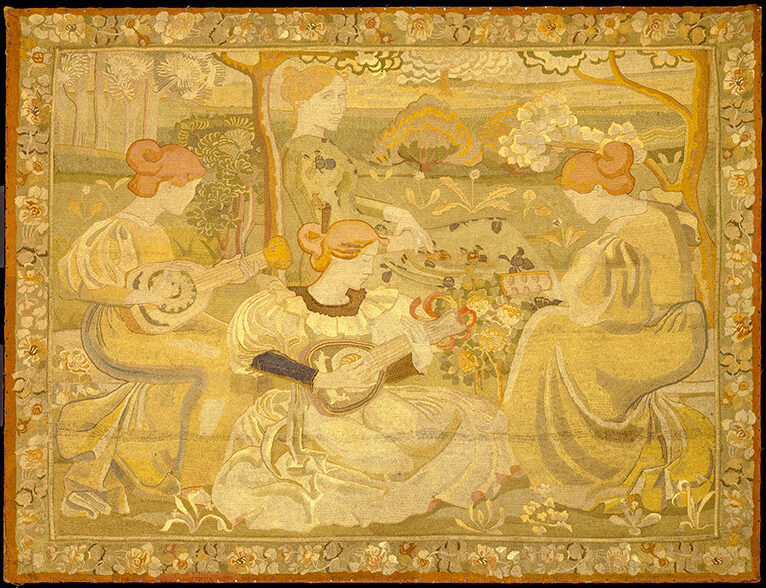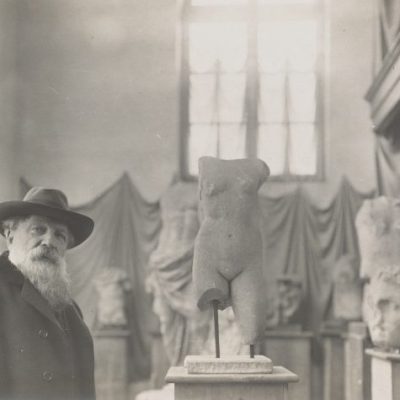From the July/August 2022 issue of Apollo. Preview and subscribe here.
In the middle of the 20th century Aristide Maillol (1861–1944) was thought of as the most eminent representative of modern sculpture. That he is no longer regarded in this way can be put down to various reasons, but this exhibition will do little to return him to the position he once held. Rather, it will place him more firmly in the company of decorative and applied artists from the turn of the 20th century – the company, that is, of those artists represented by the Musée d’Orsay, whose official remit ends in 1914.
Although there is plenty of sculpture in this exhibition, the decorative arts here are more revelatory. Their scale is domestic, and the feel of the display itself that of a fin-de-siècle salon interior. One of the more delightful aspects of the exhibition is the way in which it places Maillol’s works in the houses of his friends – Denis, Bonnard, Renoir, Vuillard – and allows us to see them as part of the ‘furniture’ of their paintings.
The subtitle of the exhibition gives a fair indication of its tone. ‘Aristide Maillol: The Quest for Harmony’ is a surprisingly straightforward monographic exhibition, which seeks rather to gather together a lot of works than to analyse them and their effect. The show has an impressive list of exhibits, 157 in total, with nearly half on loan from either the Fondation Dina Vierny or via the Galerie Dina Vierny – a clear indication of the debt which the Museum owes Maillol’s last model, with whom he worked throughout the final decade of his life. The continued close involvement of Vierny’s family has profoundly affected studies of Maillol, who is still effectively a ‘private’ artist when compared with those contemporaries whose sculptural legacies are now fully within the fold of the French museum system.
Concert de femmes (1895), Aristide Maillol. Photo: Pernille Klemp; © © Design Museum Denmark, Copenhagen

The exhibition expands our knowledge of Maillol’s two-dimensional work – not just his paintings of the female profile, but his textiles, prints and illustrations; this focus on line and relief in the early part of the exhibition makes for an effective transition into the sculptures. Lesser-known works are most in evidence here, including the Concert de femmes, a large embroidery on loan from Copenhagen, and a striking polychrome terracotta relief of the Virgin, normally in Perpignan.
Some of the themes explored here – notably Maillol’s reception in Germany, but also the question of his attitudes to sex – are potentially very complicated, especially given the politics of Franco-German relations in these years. But the exhibition deals with these problems briskly and in a manner that shuts down discussion rather than opening it up. Instead we are offered a comforting, almost old-fashioned, vision which supports rather than unsettles the straightforward understanding of Maillol’s sculpture as being in line with the classical turn after the First World War.
At the centre of the display, and existing almost in parallel to the narrative sections spaced around the walls, are three islands of sculpture, bringing together Maillol’s major three-dimensional works. Among them are the early stone and plaster crouching figures which, like Méditerrannée, reduce the figure to cubic form. The bronze statues, such as The Seasons, stand upright, well balanced, more frontal. The late reclining nudes, such as L’Air, pivot on the hip, caught in a perennially arresting state of (un)balance.
Within the physical constraints of the gallery, these are well displayed, but the effect of these powerful works is greatly reduced by the low ceilings of the galleries. Only when one leaves the exhibition, and crosses into the central hall of the museum, does one confront a sculpture ‘in liberty’. The full figure of Action enchaînée, striding across the floor, but thrusting upwards into the air as well, reminds us why Maillol was so beloved of architects. This central space might have been more fully used.
Installation view of Action enchaînée (1905–06) by Aristide Maillol at the Musée d’Orsay, Paris, in 2022. Photo: © Sophie Crépy

The spatial (architectural) aspect is an important one which, though illustrated in the catalogue, is missing from the show. Moreover, although the catalogue shows the ways in which his sculptures were used in early 20th-century buildings, it does not look much beyond this; with more than 30 short essays by 10 authors, it indicates the pluralistic nature of an exhibition without any apparent over-riding argument, but with abundant detail and close focus. Maillol’s sculptures were not just placed in European buildings, but used in projects by Mies van der Rohe and Louis Kahn. He came to embody a European classicism for Americans in a way that allowed him (or his posthumous reputation) to escape post-war opprobrium in France. The adoption of his vision in the United States is an important part of his legacy, and important also to understanding his art as a public rather than a merely private one. Having a sense of how this happened is key to understanding his success as a monumental sculptor. His magnificent Rivière still holds its own in the sculpture garden of MoMA.
The remarkable way in which Maillol’s monumental sculptures define and expand into space is, alas, something we hardly experience in the exhibition galleries. Perhaps the spaces in Zurich, where the exhibition travels in October, and Roubaix (from February 2023) will be kinder. The contemporary sculptor Charles Ray’s work is currently on show elsewhere in the city, at the Pompidou and the Bourse de Commerce, and there are striking coincidences between the two sculptors’ powerful closed forms. I can’t help wondering how it might have been if Maillol had been shown in the Pompidou (where he has every right to be) and whether then we might think of him as modern.
‘Aristide Maillol (1861–1944). The Quest for Harmony’ is at the Musée d’Orsay, Paris, until 21 August.
From the July/August 2022 issue of Apollo. Preview and subscribe here.



